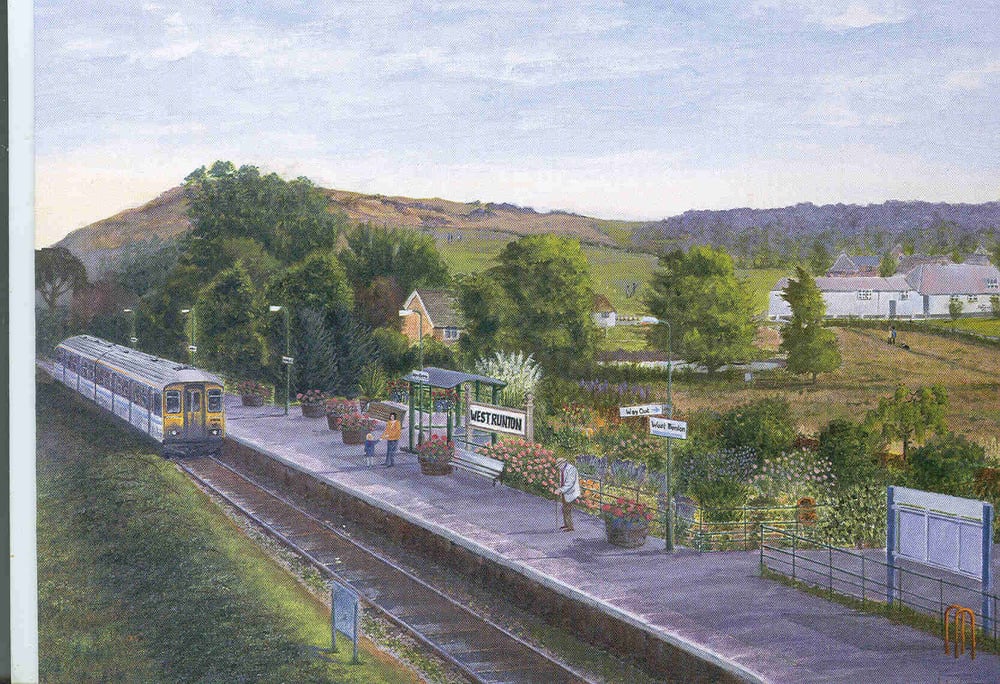WEST RUNTON STATION
|
From a painting by John Farmer for West Runton Women's Institute who sell postcards and greetings cards with this image in their endeavour to retain the station as the best-kept unstaffed station in Britain. From West Runton it is possible to travel to anywhere in Britain, or to get rapidly to the Eurostar services which will take you to Lille for services to the Med. Who needs bus services or worse still air purgatory?
The concrete sign is one of the last surviving Marriott products. The railway is the Midland & Great Northern and in its halcyon days would have provided through carriages to both Liverpool Street and to King's Cross as well as to Leicester.
Kevin has watched steam trains pass through and the progress from 150; 153 and 170 classes to the new Swiss-designed Stadler electro-diesels. The last are the best as the gap between the train is bridged and there are excellent seats and windows, He needs a time machine to imaging the MGNJR ochre; the Midland red; the Great Northern green and Great Eastern blue locomotives pass through
The Railways and Golf Come to West Runton. compiled by B. Emery.
Local railways were in their prime in the years 1890 to 1910. They had reached
the coast and were bringing in the summer visitors. The station at West Runton
had opened in 1887 CHECK and the village boasted one small shop, followed
by the Post Office. The village soon expanded after that.
East Runton did not have a station but developed as a satellite of Cromer.
The landlords of the White Horse Inn were agents for the Great Eastern Railway
by 1888 and ponies and traps for hire were kept there.
Seeing the potential that the arrival of trains gave to West Runton, a local
land owner called James Renwick Abbs decided to build a hotel in the village.
The site he chose was only 200 yards from the new station. It opened for
business in 1899 and then had 34 bedrooms. He had married a Miss Renwick,
presumably hence the middle name.
James Abbs also contacted John Henry Taylor the professional golfer. Taylor
was one of the pioneers of the modern game of golf and went on to win the
Ryder Cup in 1933. He was also a significant golf course architect and Abbs
asked Taylor to design a new golf course for his guests to enjoy, on the
land adjacent to the new hotel. The nine-hole golf course opened in 1903.
In 1906 Taylor had extended the course to 18 holes which circled around nearby
Incleborough Hill over what is now Renwick Park and tracing a route back
to the 18th opposite the Railway Station. Finally in 1912 James Abbs purchased
a clubhouse pavilion from Sheringham Golf Club and this was erected next
to the hotel.
In 1929-30 Lord Glamis who stayed regularly at Runton Old Hall, (East Runton)
was the captain. List of players include: Bobby Locke, Gary Player, Lee Trevino,
Brian Barnes, Ewan Murray, Malcolm Gregson, Brian Waites, Brian Huggett,
Sandy Lyle, Michael King and Nick Job.
After the start of WW2 the hotel was taken over along with the land of the
golf course in 1939 by troops. The course was used as a battle course and
regarded as the last training place before troops were sent overseas. There
were trenches all over Deers Hill with barbed wire everywhere. After renovation
it opened again in 1949 and Bobby Locke played a charity match there .. By
1953 however the Hotel had closed down and the golf club was wound up owing
mainly to the lack of player members.
In 1955 an application for the caravan site nearby was approved. Enter Brian
Plumpton in 1956, who re-opened the Hotel and set about restoring the golf
course. New owner Tom Watson, in 1970s had plans for the course and club
and appointed a club professional. The course was restored to 9 holes.
Gary Player was appointed as playing professional and Director of Golf at
the Links Hotel and Golf Club and represented the resort whenever he played
in the British Isles. Sir Henry Cotton who won the open 3 times, stayed at
the Hotel to play. A Suffolk farmer, Andrew Morton, stayed at the hotel and
liked it so much that he bought it. After him came the Abbot family. Another
bit of legend is that West Runton was the scene of the first ladies golf
to be played on a Sunday although there is no documentation to prove this.
However Sunday play was allowed for all guests. the green fee rate was fifteen
shillings (75pence) for men and twelve shillings and sixpence for ladies.

